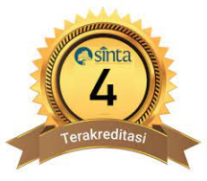NEED ANALYSIS STUDY: CRITICAL THINKING DISPOSITION PROFILE OF SCIENCE CLASS STUDENT IN HIGH SCHOOL
Abstract
Full Text:
PDFReferences
Costa, A and Kallick, B., Habits of Mind: A Developmental Series.Alexandria, VA: Association for Supervision and Curriculum Development, 2000.
Yamin, M., Strategi Pembelajaran Berbasis Kompetensi. Jakarta: Gaung Persada (GP) Press, 2009.
Tishman, S., Andrade, A., Thingking dispositions: a Review of Current Theories, Practice, and Issue. Cambridge, MA. Project Zero, Harvard University, 1996.
Norris, S., & Ennis, R., Evaluating Critical Thinking. Pacific Grove, CA: Midwest Publications, 1989.
Pascarella, E.T., & Terenzini, P.T., 2005 How College Affects Students: A Third Decade of Research (Vol. 2). San Fransisco: Jossey-Bass, 2005
Facione, P. A. & Facione, N. C., The California Critical Thinking Dispositions Inventory (CCTDI); and the CCTDI Test manual. Millbrae, CA: California Academic Press, 1990.
Ennis, R.H., A taxonomy of critical thinking dispositions and abilities. In Joan Baron & Robert Sternberg (Eds.), Teaching thinking skills: Theory and practice. New York: W.H. Freeman. Pp. 9-26, 1987.
Tishman, S., Thinking dispositions and intellectual character. Annual meetings of the American Educational Research Association. New Orleans, LA, 1994.
Facione, P.A., Facione, N.C. & Giancarlo, C.A., The Disposition Toward Critical Thinking: Its Character, Measurement and Reletionship to Critical Thinking Skill. Informal Logic, 20 (1), 61-84, 2000.
Stupnisky, R.H, Renaud, R.D, Daniels, L.M. Haynes, T.L, Perry, R.P., The Interrelation of First Year College Students’ Critical Thinking Disposition, Perceived Academic Control, and Academic Achievement. Springer Science+Bunsiness Media. Res High Educ (2008) 49:513–530, 2008
Kezer, F, dan Turker, B., Comparison of the critical thinking dispositions of (studying in the secondary science and mathematics division) preservice teachers. Procedia - Social and Behavioral Sciences 46 ( 2012 ) 1279 – 1283, 2012
Connie, SL., Approaches to Evaluate Critical Thinking Dispositions. APERA Conference 2006: 28 – 30 November 2006 Hong Kong, 2006.
Bailin, S., Critical Thinking and Science Education. Science & Education 11: 361–375, 2002. © 2002 Kluwer Academic Publishers. Printed in the Netherlands, 2002.
National Academy of Sciences, National Science Education Standards, National Academy Press, Washington, DC, 1996.
Creswell, J.W. & Clark, VLP, Designing and Conducting Mixed Method Research. United States of America: Sage Publication, Inc, 2007.
Nursyamsi, Peningkatan Kemampuan dan Disposisi Berpikir Kritis Siswa Sekolah Menengah Pertama melalui Pembelajaran Matematika Realistik. Thesis. UPI. Unpublished, 2010.
Popham, W. J. (1995). Classroom assessment: What teachers need to know. Needham Heights, MA: Allyn and Bacon.
McElmeel, S.L, Character Education: A Book Guide for Teachers, Librarians, and Parents. Greenwood Village, Colorado: Greenwood Publishing Group, 2002.
Perkins, D. N., Jay, E., & Tishman, S, Beyond abilities: A dispositional theory of thinking. Merrill-Palmer Quarterly, 39(1), 1-21, 1993.
Rowson, J, The power of Curiosity. RSA Social Brain Centre June 2012. www.thersa.org, 2012.
Binson, B, Curiosity Based Learning Program. US-China Education Review, 12(6), 13-22, 2009.
Komara, I.B., Hubungan antara Kepercayaan Diri dan Prestasi belajar dan Perencanaan Karir Siswa. Psikopedagogia 2016.Vol.5.No.1, 2016.
Sihotang, L. Setiawan, D. & Saragi, D., The Effectof Learning Strategy and Self Confidence Toward Student’s Learning Outcomes in Elementary School. IOSR Journal of Research & Method inEducation. Volume 7, Issue 4 Ver. I 65-72, 2017.
Suprijino, A., Cooperative Learning : Teori & Aplikasinya. Yogyakarta: Pustaka Pelajar, 2010.
Kanari, Z., & Millar, R., Reasoning from data: How students collect and Interpret data in science investigations. Journal of Research in Science Teaching, 41(7), 748-769, 2004.
Nurhayati, Yuliati, L., Mufti, N., Pola penalaran ilmiah dan kemampuan penyelesaikan masalah sintesis fisika. Jurnal Pendidikan Vol.1.2016.
Styron, R.A., Critical Thinking and Collaboration: A strategy to enhance student learning. Systemics, Cybernetics, and Informatics Vol. 12, No. 7, 2014.
DOI: http://dx.doi.org/10.24036/14479171074








